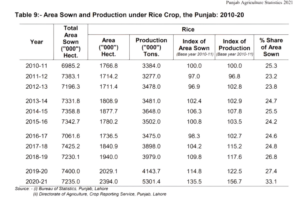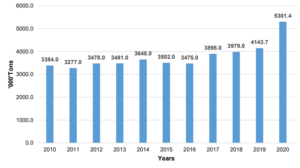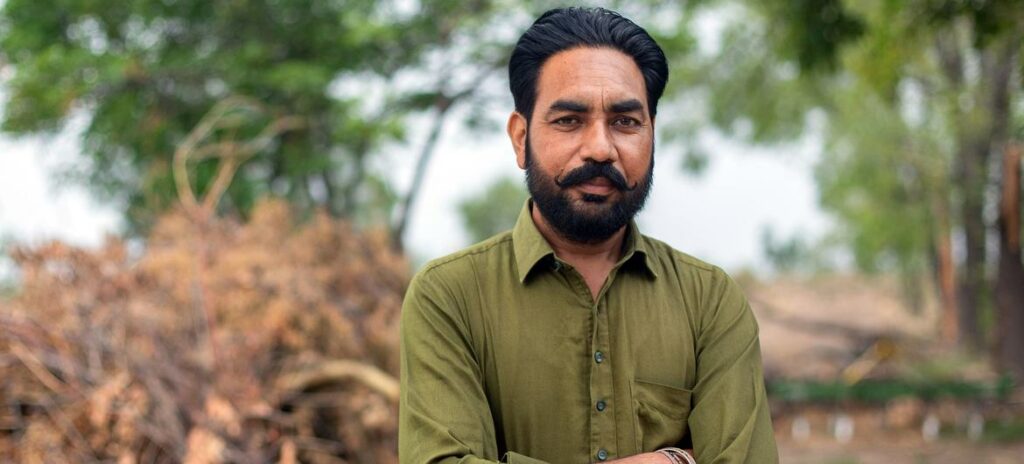All economic sectors, especially agriculture, are at risk from climate change. As a fast-paced developing country, Pakistan has been grappling with the current climate crisis as it struggles to build an efficient, sustainable economy. With a large and rapidly growing population, lack of an adaptive infrastructure, and high exposure to extreme drought- and heat-related climate events, Pakistan is one of the most highly affected regions struggling with the effects of climate change. Climate vulnerability puts farmers in Pakistan at risk, not only causing strain within the agricultural communities, but also negatively affecting the country’s economy. “Agriculture is the mainstay of Pakistan’s economy. It accounts for 19% of the GDP, and agro-based products fetched 80% of the country’s total earnings. More than 42.3% of the labor force is engaged in this sector”.1
One major farming area within Pakistan is the transnational region of Punjab. Along its eastern border with India, this region is the second largest farming area in Pakistan, dedicating 72% of its 20.63 million hectares [206,300 square kilometers] to agriculture. The bulk of this agricultural area is dedicated to just three crops: wheat (40 %), cotton (15.5%), and rice (12.8%).2 Since 2010, rice has become a major staple crop within Pakistan, and is one of the more lucrative farming areas within the Punjab region. Due to this increase in demand, yield has been forced to rapidly increase causing more competition between farmers and a faster depletion of natural ground water resources.
Rice Crop Statistics & Cultivation
Agricultural cultivation has expanded in the last decade (Figure 1): “By taking 2010-11 as a base year, it has been observed that there is a 35.5% increase in the index of area sown during the year 2020-21, and similarly, an increase in the production can be observed during the same which is 56.7%”.3

Groundwater is water that has seeped below the surface though soil, sand, and cracks within the rocks. Below the water table, this water fills empty spaces within rock layers. The water within these “saturated zones” travels down into the ground until it reaches a level of rock that it cannot flow through. Once water reaches this “impermeable rock”, it moves surrounding rock permeable formations and sediments called aquifers.6 Groundwater is extremely important as it supplies most of the world’s fresh water needs, and is a growing source for agricultural irrigation. At the same time as groundwater demand is increasing, however, climate change affects weather and rainfall patterns that can reduce available groundwater supplies.
With the massive increase of rice production and the impacts of consistent climate change-induced heat increases and droughts, the demand for groundwater to properly grow rice is becoming increasingly difficult for local farmers to manage. Unfortunately, groundwater is not a never-ending supply of flowing water. As population increases so does demand, thus creating competition between neighboring rice farmers. Competition created by over-consumption, combined with extended periods of drought and increased variability in precipitation due to climate change, causes a massive depletion of available groundwater resources.7
The current rate at which groundwater is being depleted in Punjab greatly outweighs the amount that is recharged into the system, and groundwater is rapidly approaching a non-renewable resource in the region. Helping farmers to understand the need to develop less labor-intensive and more sustainable practices is key, but money restrictions and a lack of governmental aid result in poor educational resources and a lack of climate awareness. More modern farming practices would help to make farming a more attractive option for communities in the Punjab region and increase rice production, but the larger tax burden from increased production includes no reliable governmental funding in return, and planting by hand is a community rice farmers’ best, if not only, option.8
Governmental Discourse

The Indian parliament has not passed any additional legislation regarding climate or agricultural issues. In response to these laws, many peaceful protests, beginning in 2020, encouraged civil change. Unfortunately, in January of 2021, violent outbreaks occurred, resulting in many Punjabi farmers’ deaths.14 Protests for agricultural justice have continued into 2023, but disregard for the environmental and livable needs of Punjab’s farming community in the face of major drought, have resulted in water and housing security concerns persisting throughout the agricultural population. There is still a shortage of financial resources in smaller farming communities that still make up the backbone of Punjab and Pakistan’s economic agricultural prosperity. Without consistent support from local and national governments, local farmers may be losing hope.
Up-close and Personal with Local Punjab Farmers
To better understand the true struggles for sustainable water resources in a community, and to gain a greater understanding of the current crisis, one must be willing to go to the source. Amandeep Singh, a landowner and farmer in the Punjab region of India observed that around a decade ago, he only needed to dig down about 9 to 12 meters to access groundwater. Unfortunately, today he has noticed that the depth-to-water has increased to around 18 to as much as 21 meters in some areas. “Every year, we have to dig deeper to reach the groundwater. This is not just a problem for future generations, but something we experience today already”.15 Trying to find deeper groundwater isn’t free, requiring machinery and/or specialized labor to find and produce water for irrigation. Amandeep expressed concern that although it is a significant expensive, he and many other landowners don’t have any other choice. He notes that the future of farming is at risk, not only for local agricultural communities, but for all people throughout the region. He states that without water, not only will viable drinking sources become scarce, but so will the production of food throughout Punjab and India.

- Agriculture Department, Government of the Punjab. Overview | Agriculture Department | Government of the Punjab. Lahore, n.d. https://agripunjab.gov.pk/overview. ↵
- Agriculture Department, Government of the Punjab. Overview | Agriculture Department | Government of the Punjab. Lahore, n.d. https://agripunjab.gov.pk/overview. ↵
- Government of Punjab, Bureau of Statistics. Punjab Agriculture Statistics -2021. Bureau of Statistics, Planning & Development Board, Government of the Punjab, 2021. https://bos.punjab.gov.pk/system/files/FinalPASS2021.pdf. ↵
- Government of Punjab, Bureau of Statistics. Punjab Agriculture Statistics -2021. Bureau of Statistics, Planning & Development Board, Government of the Punjab, 2021. https://bos.punjab.gov.pk/system/files/FinalPASS2021.pdf. ↵
- Government of Punjab, Bureau of Statistics. Punjab Agriculture Statistics -2021. Bureau of Statistics, Planning & Development Board, Government of the Punjab, 2021. https://bos.punjab.gov.pk/system/files/FinalPASS2021.pdf. ↵
- Nugent, Helen. What Is Groundwater and How Can We Better Protect It? World Economic Forum, August 23, 2022. https://www.weforum.org/agenda/2022/08/groundwater-matter-life-earth/. ↵
- Deregibus, Ignacio. “The Effects of Climate Change on Groundwater: An Out-Of-Sight Crisis.” International Institute for Sustainable Development, November 2, 2020. https://www.iisd.org/articles/insight/effects-climate-change-groundwater-out-sight-crisis. ↵
- Kumar, Suresh. “Punjab’s Agriculture Policy Needs a Digital Push to Make Farming Preferred Occupation for Youth – ET Government.” ETGovernment.com, January 30, 2023. https://government.economictimes.indiatimes.com/blog/punjabs-agriculture-policy-needs-a-digital-push-to-make-farming-preferred-occupation-for-youth/97435908. ↵
- Government of Punjab, Bureau of Statistics. Punjab Agriculture Statistics -2021. Bureau of Statistics, Planning & Development Board, Government of the Punjab, 2021. https://bos.punjab.gov.pk/system/files/FinalPASS2021.pdf. ↵
- Kumar, Suresh. “Punjab’s Agriculture Policy Needs a Digital Push to Make Farming Preferred Occupation for Youth – ET Government.” ETGovernment.com, January 30, 2023. https://government.economictimes.indiatimes.com/blog/punjabs-agriculture-policy-needs-a-digital-push-to-make-farming-preferred-occupation-for-youth/97435908. ↵
- Why are the farmers of Punjab protesting? | Surinder S. Jodhka, 31 Oct 2021, Why are the farmers of Punjab protesting?: The Journal of Peasant Studies: Vol 48, No 7 (tandfonline.com). ↵
- BBC. “India Farmers’ Protests: Punjab Families Grieve Their Dead.” December 8, 2021. https://www.bbc.com/news/world-asia-india-59574938. ↵
- Why are the farmers of Punjab protesting? | Surinder S. Jodhka, 31 Oct 2021, Why are the farmers of Punjab protesting?: The Journal of Peasant Studies: Vol 48, No 7 (tandfonline.com). ↵
- BBC. “India Farmers’ Protests: Punjab Families Grieve Their Dead.” December 8, 2021. https://www.bbc.com/news/world-asia-india-59574938. ↵
- First Person: Farmers running out of water in Punjab, India | United Nations, 2023, First Person: Farmers running out of water in Punjab, India | UN News. ↵
- First Person: Farmers running out of water in Punjab, India | United Nations, 2023, First Person: Farmers running out of water in Punjab, India | UN News. ↵


